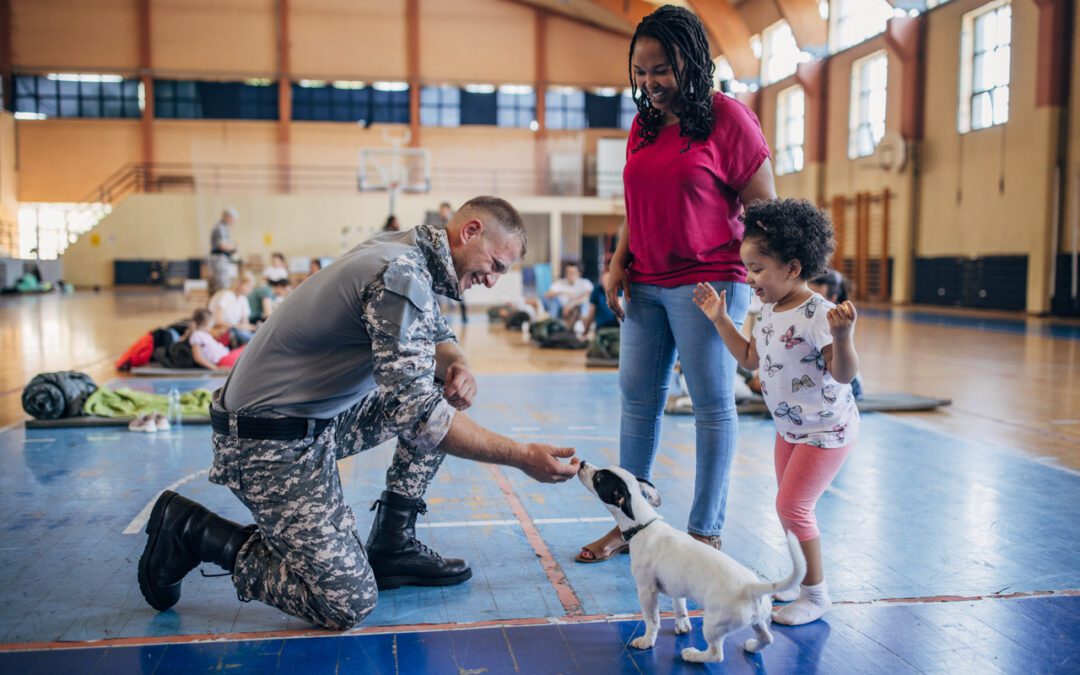Santa Cruz County residents are no strangers to natural disasters, and you may already have a plan to care for your pets in case of a prolonged power outage, wildfire, flood, or if you need to evacuate. As September is National Disaster Preparedness Month, it is an excellent time to review best practices to be ready to care for your pets should a natural disaster strike.
Disaster Planning 101
Disaster response planning takes time and energy and can be overwhelming. Try tackling one thing at a time to ensure you stay on track and keep things manageable.
Power outages. Power outages are becoming more common for various reasons all over the nation. Unfortunately, there’s no way to predict how long a power outage will last, so be prepared with a two-week supply of your pet’s food and enough bottled water. If your pet is on any long-term medication, ensure you have a two-week supply since prescription refills may not be available during an emergency.
You’ll want to keep a printed contact list of phone numbers for your pet if cell phones aren’t working. Your list should include your pet’s regular family veterinarian, the Animal Poison Control Hotline, and emergency clinic numbers. During a natural disaster, the Santa Cruz County Animal Shelter will likely provide temporary shelter for pets, as during the CZU fire. Most emergency clinics will remain open during natural disasters such as wildfires and continue serving animals in need. Call us anytime if you have questions or concerns about your pet.
Evacuation planning. When you receive an evacuation order, it is impossible to know when you’ll be able to return, as circumstances often change during a disaster. Since you may not be allowed (or able) to return to your home as soon as you wish, always plan to take your pets with you. Emergency responders may be unable to get to your pet, so the safest place for them is with you.
If you’re not home during an evacuation, enlist the help of a neighbor or friend to evacuate your pets for you. Speak with them in advance before there is a crisis. Make sure they have a key to your home, know your pets and their usual hiding places, and can quickly locate your pet’s evacuation kit.
The ASPCA provides a free pet safety pack, which includes “animals inside” pet rescue window and door decals to alert neighbors and first responders that your pets may be inside your home and need rescuing.
Evacuation shelters may not accept pets, so having a pet-friendly backup plan is crucial. Create a list of friends, family, pet-friendly hotels, campgrounds, veterinary clinics, and boarding facilities in your immediate area and farther away in case of a significant event. If you believe evacuation is likely, call ahead to reserve boarding and hotels, as they may fill quickly.
Create a Pet Evacuation Kit
Whatever the emergency, having all your pet’s necessities gathered ahead of time in an organized location will make everyone’s life easier. Create a pet evacuation kit and keep it in an easily accessible spot so you can grab it and go easily and quickly if necessary. A plastic tote often works well to keep the following items in a transportable “go bag:”
Your pet’s evacuation kit should include:
- An extra collar or harness and leash with ID tags attached
- A soft-sided pet carrier or crate
- A two-week supply of your pet’s medications, especially if they take long term medication
- A two-week supply of food and water (rotate perishables every two weeks)
- If your pet eats canned food, pack pop-top cans or a can opener
- Food and water bowls, canned food lids
- A litter box, scoop, a two-week supply of litter
- Spray cleaner, paper towels, and pet waste bags
- A pet first aid kit
- Towels and blankets
- A special toy, treats, pet bed, and comfort items for your pet
- Printed veterinary records and a current printed photo of your pet
- Printed lists of contact numbers and pet-friendly accommodations
The Importance of Pet Identification
Unfortunately, in the chaos of a natural disaster and the subsequent response, pets often escape and become lost. We recommend keeping your pet’s ID tags and microchip contact information current with several contact numbers. If your pet becomes lost, a microchip can significantly increase the chances that you and your pet will be reunited since a microchip can never be damaged, removed, or lost, as a collar and tags sometimes are.
After the Storm
After a storm or disaster, pets may continue feeling extreme stress and anxiety and try to escape in a panic. In addition, just like people, strange noises, smells, and environments may disorient or confuse them. Pets need time and patience to re-acclimate after a disaster or significant change. Most cats especially dislike any change in their routine. For these reasons, keeping pets on a leash and cats in carriers is a good idea until you feel confident they are reacclimated to their surroundings.
To help ease their transition, you can give your pets extra snuggles, kind pats, and quiet, positive words. Do your best to provide a safe and calm environment, even if not their own home.
If you are separated from your pet before, during, or after a natural disaster, begin your search at our local animal shelter. Emergency responders are familiar with pet-friendly shelters and will often post lists of pets who have been rescued and where they have been taken. Local news organizations are also excellent sources of information sharing and locating lost pets.
Planning for an emergency can be overwhelming, but we hope these ideas have made tackling one thing at a time more manageable. Being ready for a natural disaster with pets can save time and stress. Please call us if you want more information about disaster preparedness with pets.

